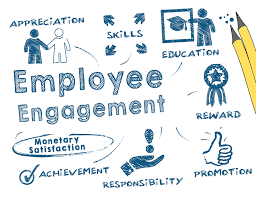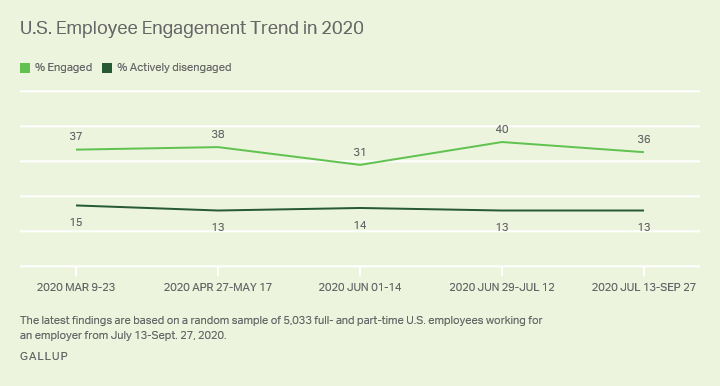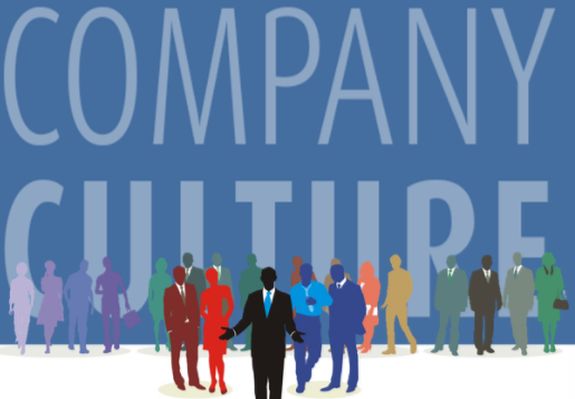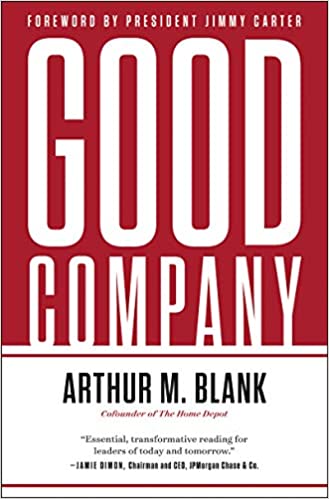
Life grants nothing to us mortals without hard work. – Horace
A new report issued by the Gallup organization sheds new light on the state of employee engagement in the midst of the pandemic.
The report states that those who are “highly involved in, enthusiastic and committed to their workplace-has dropped back (from a previous high of 40%) to just slightly above the pre-COVID-19 rate of 35%, to 36%”. The report goes on to say that “the percentage of workers who are “actively disengaged”–those who have miserable work experiences and spread their unhappiness to their colleagues–in this latest survey remains the same, at 13%”.

Two more noteworthy takeaways from the report say that the largest decline in employee engagement was among those in managerial or leadership positions and that the drop was also sharper for people working on-site versus at home and among blue-collar or service workers. The drop was larger for men than women.
How do these findings stack up against what you know and are experiencing at your place of work?
To be sure, the COVID pandemic altered the way in which we work, collaborate, and daily find satisfaction with our careers. It’s been challenging on multiple levels. And as leaders, we know and understand that the challenges presented to many at the beginning of the pandemic continue with us today.
We realize that the challenges of employee engagement will vary from business to business and from person to person. Here, we want to offer some tips for leaders to help you process what’s taking place and give you some encouragement going forward.
Acknowledge where you are today
It can be overwhelming to think about slips in employee engagement merely by looking at survey results. Before you embrace the results of this or any other survey, embrace what is true and peculiar to your people and in your organization.
Acknowledge what is true about your organization and build from there. At the end of the day your numbers may reflect something direr, it may reflect something more positive, but either way, start with where you are at.
Focus on managers and leaders
As stated in the report, the single largest drop in employee engagement was among those in managerial and leadership positions. If engagement is waning among your managers and among your leadership team, then it is incumbent upon you to get ahead of it and figure out where the deficiencies are. Before you can stop the disengagement among all of your employees, you must stop it among your leaders. Click To TweetDuring this time, worry less about the cosmetics of it and focus more on content and relationships.
For each day and week that goes by without correcting the course, it only moves you further in the wrong direction. Rally around your management team and give them the support they need. This will not only help them but they in turn will be able to plug the holes elsewhere.
Acknowledge that these are not normal times
While it is tempting to want your company leadership, management team, and even employees to get back to work as if things were normal, they aren’t. This expectation just adds to the stress and disengagement you are experiencing in your organization. When we are stressed, we easily become distracted from the tasks we need to focus on and turn our attention to the very thing that is causing us stress.
Acknowledging that things are not normal and helping your entire organization accept that work will look and feel different for the foreseeable future goes a long way in alleviating stress in the workplace. Be transparent in communicating where the organization is right now, what the projections are for the short-term, and what your strategic plan is to mitigate the negative impact that COVID has on your workforce. Solicit input from your teams as to what they need in order to perform during this stressful time.
A little gratitude goes a long way
This is no time to take your people for granted. Everyone is operating under less than optimal circumstances. Your teams have had to adapt, in the blink of an eye, to new ways of getting work done. While engagement may have taken a hit during this time, how many of your people have stepped up to the plate?
Showing your gratitude for their hard work during times of stress and uncertainty will go a long way. When you make your people feel appreciated, you gain loyalty and a renewed commitment to their responsibilities. Click To TweetShow enthusiasm toward them and the vital role that they play in the success of the organization.
Final Thoughts
Employee engagement is waning and we are all wrestling with the challenges of how to work and collaborate effectively during the COVID pandemic. As a leader, it is your responsibility to step into the gap, reach out, and provide support and encouragement during this stressful and uncertain time. Your company leadership, management team, and employees need to know that you are in this with them more than ever. Your positive and inspiring leadership during this time of hardship will result in improved loyalty, morale, productivity, and yes, even engagement.
©2020 Doug Dickerson and Liz Stincelli
Check out these additional resources on employee engagement by Doug and Liz:
Moving From Buy-In to Engagement: Why Buy-in May Not Be Enough
7 Reasons Why Your Leadership Style is Causing Workplace Drama

Read more from Liz Stincelli at http://www.stincelliadvisors.com/





